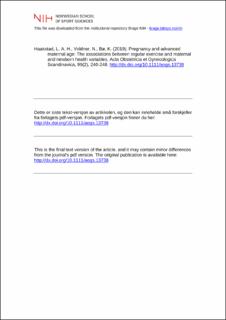| dc.description.abstract | Introduction: Despite the associations between delayed childbearing and poorer maternal and perinatal outcomes, little is known about these issues in regular exercisers and in women with healthy lifestyles. The aims of the present study were to : (a) compare lifestyle variables and exercise, pregnancy and birth outcomes in women ≥35 years and women <35 years of age, and (b) investigate the associations between regular exercise and maternal health and newborn variables in women of advanced maternal age. Material and methods: Healthy pregnant women (≥35 years, n = 104 and <35 years, n = 362) were allocated to the study from Rikshospitalet, Oslo University Hospital, Norway. The participants completed a validated self‐administered questionnaire, the Physical Activity Pregnancy Questionnaire (PAPQ) in gestational weeks 32‐36. Prepregnancy body weight (kg) was self‐reported, whereas maternal weight (kg) was measured at gestational weeks 14‐16, 22‐24, 30‐32, and 36‐38. Details of the delivery (gestational week at delivery, mode of delivery, Apgar score) and birthweight (g) were obtained from the hospital’s medical records. Results: More women <35 than ≥35 years of age reported to have exercised prepregnancy (83.7% vs 74.0%, P = 0.04) and in the 1st trimester (71.2% vs 61.5%, P = 0.05). At gestational week 36, fewer than 50% were exercising regularly, with no group differences (P = 0.74). Current alcohol use (10.5% vs 3.3%, P = 0.02) and tobacco use (5.8% vs 1.7%, P = 0.02) were higher among women ≥35 than women <35 years, whereas for healthy diet the result was reversed (<35 years 67.1% and ≥35 years 80.8%, P = 0.02). There were higher rates of post‐term birth (13.5% vs 6.4%, P = 0.02) and induction of labor (40.5% vs 27.9%, P = 0.02) in the ≥35 years group, otherwise no other differences were observed in perinatal outcomes. In women with advanced maternal age, exercising ≥2 times weekly was associated with less pelvic girdle pain (40.0% vs 61.1%, P = 0.02), lower gestational weight gain (12.7 ± 4.0 kg vs 15.5 ± 5.5 kg, P < 0.01), fewer had gestational weight gain ≥16 kg (22.0% vs 51.9%, P < 0.01) and a newborn with macrosomia (10.0% vs 37.0%, P < 0.01). The results were unchanged after adjusting for recognized confounders. | en_US |
